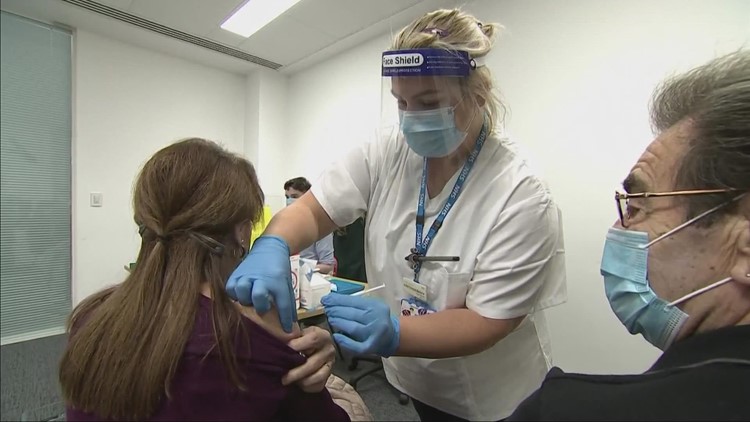COVID Tracker: San Antonio hospitalizations dip under 100 for the first time in months

Daily case counts continue to fall as well.
SAN ANTONIO — For the first time since early June, San Antonio-area coronavirus hospitalizations have dipped into the double-digits as Texas continues its slow emergence from the pandemic.
There were 94 patients receiving treatment for their symptoms Tuesday, which is down 28% over the last week and down 55% since Sept. 1. Of those 94 patients, 13 were in intensive care and two were using ventilators to help them breathe.
Case counts continue to shrink as well; Tuesday’s 152 new infections were the most since last week, but October thus far has averaged just 134 new cases a day to 414 in September and 735 in August. More than 646,000 coronavirus cases have been reported in Bexar County since the pandemic began, though there are likely at least thousands more positive at-home diagnoses that weren’t reported.
Metro Health continues to organize pop-up clinics for no-cost COVID-19 vaccines; the next one is set for Wednesday at a west-side community center.
It’s been nearly two weeks since Bexar County last recorded a COVID-related death.
How Bexar County is trending
Vaccine progress in Bexar County
The following numbers are provided by San Antonio Metro Health. A full breakdown can be found here.
- 1,481,332 eligible Bexar County residents are fully vaccinated as of Oct. 10, which is about 73.9% of the total population over 6 months old.
- 591,339 eligible Bexar County residents have received a COVID-19 booster shot as of Oct. 10, which is 39.7% percent of the population over 4 years old.
The CDC states that “when a high percentage of the community is immune to a disease (through vaccination and/or prior illness),” that community will have reached herd immunity, “making the spread of this disease from person to person unlikely.”
The City of San Antonio breaks down the vaccination rates by zip code on Metro Health’s Vaccination Statistics page.
Coronavirus in Texas
The total number of coronavirus cases in the state grew by 637 on Monday, according to the Texas Department of State Health Services. That total includes 473 new confirmed cases and 164 new probable cases. More details can be found on this page.
Monday’s figures bring the total number of Texans diagnosed with COVID-19 to more than 7.9 million.
Meanwhile, two more Texans have died from virus complications, the state reported Monday, raising the statewide death toll to 89,429. The latest daily figures, for Tuesday, weren’t yet released by state officials.
Coronavirus symptoms
The symptoms of coronavirus can be similar to the flu or a bad cold. Symptoms include fever or chills, cough, shortness of breath or difficulty breathing, fatigue, muscle or body aches, headache, new loss of taste or smell sore throat, congestion or runny nose, nausea or vomiting, and diarrhea, according to the Centers for Disease Control.
Most healthy people will have mild symptoms. A study of more than 72,000 patients by the Centers for Disease Control in China showed 80 percent of the cases there were mild.
But infections can cause pneumonia, severe acute respiratory syndrome, kidney failure, and even death, according to the World Health Organization. Older people with underlying health conditions are most at risk.
Experts determined there was consistent evidence these conditions increase a person’s risk, regardless of age:
- Chronic kidney disease
- COPD (chronic obstructive pulmonary disease)
- Obesity (BMI of 30 or higher)
- Immunocompromised state (weakened immune system) from solid organ transplant
- Serious heart conditions, such as heart failure, coronary artery disease, or cardiomyopathies
- Sickle cell disease
- Type 2 diabetes
- The CDC believes symptoms may appear anywhere from two to 14 days after being exposed.
Human coronaviruses are usually spread…
- Between people who are in close contact with one another (within about 6 feet).
- Through respiratory droplets produced when an infected person coughs, sneezes or talks. These droplets can land in the mouths or noses of people who are nearby or possibly be inhaled into the lungs.
- Some recent studies have suggested that COVID-19 may be spread by people who are not showing symptoms.
Help stop the spread of coronavirus
- Stay home when you are sick.
- Eat and sleep separately from your family members
- Use different utensils and dishes
- Cover your cough or sneeze with your arm, not your hand.
- If you use a tissue, throw it in the trash.
Find a testing location
City officials recommend getting a COVID-19 test if you experience fever or chills, cough, shortness of breath or difficulty breathing, fatigue, muscle or body aches, headache, new loss of taste or smell, sore throat, congestion or runny nose, nausea or vomiting, or diarrhea.
Here’s a Testing Sites Locator to help you find the testing location closest to you in San Antonio.
Latest Coronavirus Headlines
Dallas Press News – Latest News:
Dallas Local News || Fort Worth Local News | Texas State News || Crime and Safety News || National news || Business News || Health News
texasstandard.news contributed to this report.










